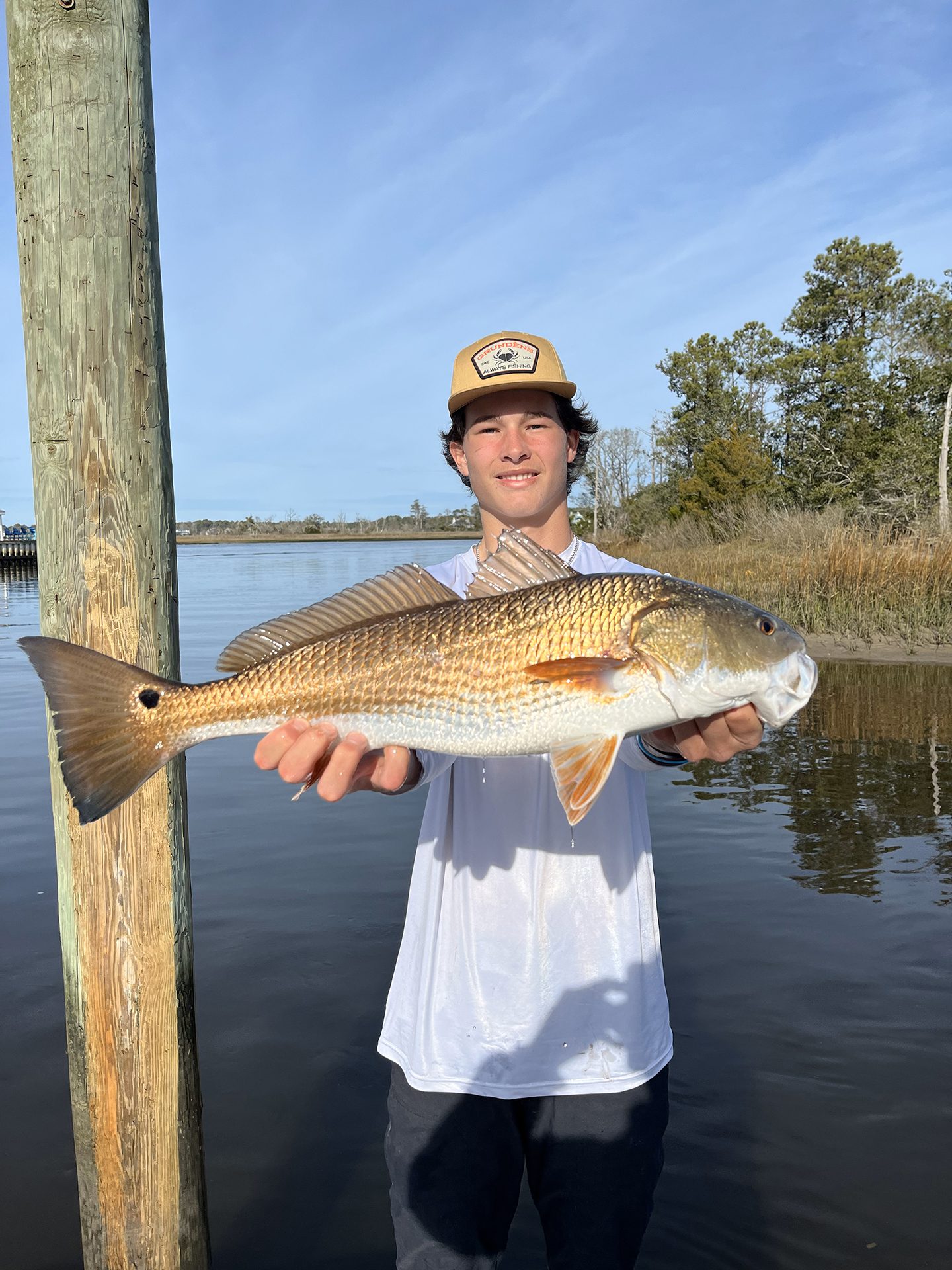Southport/Oak Island – March 2024
Matt, of Dutchman Creek Bait and Tackle, reports that water temperatures are cold in the area, and that has the bite generally slower until conditions turn.
Nearshore anglers can run out to catch black sea bass in the 10-40 mile range anytime the weather gives a favorable window.
The shallower reefs should start seeing better catches of gray trout.
Moving later into March, nearshore anglers are watching for water temperatures to get near 60 degrees. Around then is when we see bluefish, and then not too far behind them, the earliest of spanish mackerel.
Inshore anglers are currently picking away at trout, and they’re targeting them in their deep wintering holes while fishing slowly. Next month, the trout bite should pick up, along with red drum, as water temperatures bring more active feeding.
Garrett, of Oak Island Sporting Goods, reports that the surf zone is slowly starting to come alive, with anglers catching some whiting alongside pufferfish.
The local piers have been landing some black drum.
Inshore anglers are finding good numbers of black drum while bottom fishing with shrimp in the creeks and in holes around oyster beds.
Speckled trout fishing inside has been a bit slow, with success being found by anglers way up in the creeks rigged with live or artificial shrimp.
Not much has been happening nearshore outside of sheepshead being caught on the shallower reefs.
Going into March, look for plenty of black drum action both inshore and along the beaches.
Whiting and pufferfish catches only get better as more fish push into the area.
A change in inshore water temperatures will see the trout action pick up, with red drum also becoming more active, as both break out of winter patterns.
Nearshore anglers will be on the lookout for the arrival of bluefish and schools of false albacore.

Capt. Robert Capps, of Reelin’ Pelican Charters, and his daughters Sailor (age 3) and Harbor (age 1), with a couple of wintertime redfish caught using dead shrimp in a Southport area creek.
Robert, of Reelin’ Pelican Fishing Charters, reports that anglers getting their hands on live shrimp have done well targeting inshore species. Smaller speckled trout (to 15”), sheepshead, black drum, and lower-slot red drum are all feeding on the shrimp. Fishing shrimp under a cork is about the easiest setup to use in the winter, with anglers only needing to make adjustments for the depth you are fishing to keep baits near (but not on) the bottom. If dealing with strong currents, then you should switch over to Carolina rigs.
All these inshore species are holding in the same types of spots, such as deeper holes (8-10’) in the backs of canals and creeks. Some nearby oysters or structure is only a benefit when testing out a spot. With the water conditions, it can be best to fish during low tides when the fish are more congregated into the holes and less likely to migrate.
Hunter, of Dockside Fishing Charters, reports that the redfish bite has been steady. These bigger winter schools are back in the skinny water and hitting jerk shads and Vudu shrimp. Most of the redfish have been the smaller “rat” reds, with the slot-sized fish only sprinkled in.
Anglers have also been able to find some reds stacked up in deep holes near structure. These fish are better targeted with live shrimp under slip corks.
Black drum are staged up in deeper pockets, and they’re mostly feeding on Carolina-rigged cut shrimp.
Speckled trout fishing has been up and down. The good news is that the quality has been really good, with fish in the 18-26” range.
Mark, of Angry Pelican Charters, reports that early spring fishing action is right around the corner, with offshore water temperatures warming almost daily.
Bottom fishing in the 50-65’ range should provide plenty of action on black sea bass and gray trout.
Pushing out to deeper structure should find both of the above species, as well as some stud American red snapper, king mackerel, and amberjacks.
Closer to the beach, black drum will start firing up on the reefs.
Anglers should also start seeing the whiting chewing on either side of the tide cycles around the mouth of the Cape Fear River. Targeting deeper channel edges with some bottom-rigged fresh shrimp is all you need to entice strikes.

Cole Horay, of Raleigh, caught this 25″ red drum near the Oak Island Bridge using a Z-Man paddle tail soft plastic.
Ryan, of Fugitive Charters, reports that water temperatures are cold, and it may be a few weeks still until that early spring transition starts.
Anglers first can watch for schools of whiting and pufferfish to arrive around the deeper inlet areas.
Bluefish also tend to show up with them around both nearshore reefs and inlet areas.
Black sea bass can be caught in good numbers by targeting structure in the 60-70’+ range.
Getting deeper (120’+) can produce some vermilion snapper and triggerfish.
King mackerel are pushed way, way out with the water temperatures, and it may be awhile before they move in close enough to bother targeting.
Offshore anglers hope to see a tuna bite show up in the Gulf Stream by the end of March and into early April.
Denise, of Oak Island Pier, reports that March can be a good fishing month if we see water temperatures push up to that 60-degree mark.
Whiting should be showing up by then in good numbers.
Bluefish also arrive about the time those temperatures hit, and the blues definitely bring some fast action as they come in hungry.
Until then, anglers can come out and pick away at the pufferfish that have been hanging around the pier, and some sheepshead seem to be holding on the pilings.
